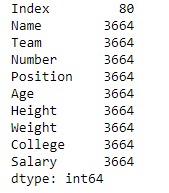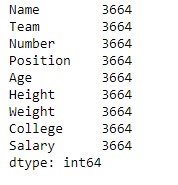Python是進行數據分析的一種出色語言,主要是因為以數據為中心的python軟件包具有奇妙的生態係統。 Pandas是其中的一種,使導入和分析數據更加容易。
Pandas dataframe.memory_usage()函數以字節為單位返回每列的內存使用情況。內存使用情況可以選擇包括索引和對象dtype元素的貢獻。默認情況下,此值顯示在DataFrame.info中。
用法: DataFrame.memory_usage(index=True, deep=False)
參數:
index:指定是否在返回的Series中包括DataFrame索引的內存使用情況。如果index = True,則索引的內存使用量將是輸出中的第一項。
deep:如果為True,則通過詢問對象dtype來深入了解數據的係統級內存消耗,並將其包含在返回值中。
返回:一個係列,其索引是原始列名,其值是每列的內存使用量(以字節為單位)
要鏈接到代碼中使用的CSV文件,請單擊此處
範例1:采用memory_usage()函數打印數據幀中每一列的內存使用情況以及索引的內存使用情況。
# importing pandas as pd
import pandas as pd
# Creating the dataframe
df = pd.read_csv("nba.csv")
# Print the dataframe
df
讓我們使用memory_usage()函數查找每一列的內存使用情況。
# Function to find memory use of each
# column along with the index
# even if we do not set index = True,
# it will show the index usage as well by default.
df.memory_usage(index = True)輸出:

範例2:采用memory_usage()函數查找每一列而不是索引的內存使用情況。
# importing pandas as pd
import pandas as pd
# Creating the dataframe
df = pd.read_csv("nba.csv")
# Function to find memory use of each
# column but not of the index
# we set index = False
df.memory_usage(index = False)輸出:

相關用法
- Python pandas.map()用法及代碼示例
- Python Pandas Series.str.len()用法及代碼示例
- Python Pandas.factorize()用法及代碼示例
- Python Pandas TimedeltaIndex.name用法及代碼示例
- Python Pandas dataframe.ne()用法及代碼示例
- Python Pandas Series.between()用法及代碼示例
- Python Pandas DataFrame.where()用法及代碼示例
- Python Pandas Series.add()用法及代碼示例
- Python Pandas.pivot_table()用法及代碼示例
- Python Pandas Series.mod()用法及代碼示例
- Python Pandas Dataframe.at[ ]用法及代碼示例
- Python Pandas Dataframe.iat[ ]用法及代碼示例
- Python Pandas.pivot()用法及代碼示例
- Python Pandas dataframe.mul()用法及代碼示例
- Python Pandas.melt()用法及代碼示例
注:本文由純淨天空篩選整理自Shubham__Ranjan大神的英文原創作品 Python | Pandas dataframe.memory_usage()。非經特殊聲明,原始代碼版權歸原作者所有,本譯文未經允許或授權,請勿轉載或複製。
